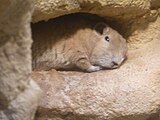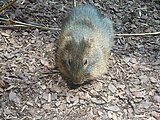Grzimek house
The Grzimek house the night animal house ( noctarium ) of Frankfurt Zoo in which animals are kept, the predominantly nocturnal are. The building named after the former zoo director Bernhard Grzimek was opened in 1978 and is the replacement for the small mammal house from 1899. The Grzimek house, together with the facility in the Bronx Zoo New York, is one of the largest nocturnal animal houses in the world. However, the Grzimek house also houses diurnal animal species that can be seen in the entrance and exit areas. A few years ago there were plans to rebuild the house, but after a short time these fizzled out.
functionality
In order to be able to demonstrate the behavior of selected animals during their nocturnal activity phase to the zoo visitors who are only present during the day, the animals are kept in the Grzimek house on an "artificial night". For this purpose, the “internal clock” of the animals is adjusted by shifting light and dark phases, so to speak, by 12 hours, so that it is “night” for them during the visiting hours. Accordingly, the lighting in the enclosures is switched on at night and is rather sparsely laid out during the day, which means that visitors have to get used to the darkness for about ten minutes after entering the dark house. After this period of familiarization, the animals shown can then be observed during their nocturnal activities.
Many animals newly brought into the Grzimek house also have to be gradually adapted to the changed light-dark period by postponing the apparent start of night every 24 hours, for example by one hour, in special acclimatization rooms. The kiwifruit could only be kept successfully after their special habituation needs had been examined in a scientific study by the University of Frankfurt .
Residents
In Tagtierbereich (18 Schaugehege) live elephant shrew , short eared elephant-shrews , Northern tree shrews , pygmy marmoset , Gundis , gold spiny mice and striped grass mouse and small square Chile and Komodo dragons . Several species are kept in some enclosures. These include the Socialization of Springtamarinen with Zwergagutis from Golden lion tamarin with ball armadillos and two-toed animals (double-deck enclosure) Kaiserschnurrbarttamarinen and Tamanduas , Cape Ground Squirrel and Siedelwebern and bush hyraxes and dwarf mongoose . The pygmy otters were given an outdoor enclosure in 2004, the lion tamarins in 2018.
The nocturnal animal area (24 show enclosures) is larger, where the only finger animals , mouse pygmy pouch rats and Seurat spiny mice (a subspecies of the Egyptian spiny mouse ) can be seen in a German zoo. In some enclosures, several animal species are also kept together, such as owl swallows and beaked hedgehogs , small hedgehog turks and fat- tailed lemurs , but also night monkeys , two-toed sloths and armadillos or bush babies , jumping hares and breeding aardvarks . Other species in the area are nocturnal drops toads ( Rhaebo guttatus ), eastern quoll , Kowaris , acrobatidae , Seba's short-tailed bat , mouse lemurs , Schlankloris , desert sleeper , porcupine and hydromys .
Former residents of the house are New Guinea Quoll , Sugar Glider , Gleichfarbkuskuse , common wombat , Bettong , several representatives of the tree-kangaroo , Great Igeltanreks , possums , hemiechinus , Golden elephant shrew , several representatives of bats , Dwarf Galago , Zwergplumploris , pottos , tarsiers , Varis , Saddleback tamarins , Rotbauchtamarine , howler monkeys , Sakis , squirrel monkeys , talapoin , Hoffmann-two-toed sloth , several members of the armadillo , callosciurinae , giant squirrel and African striped squirrel , graphiurus , phloeomys , several members of the grass mouse, gerbil , the gerbil and voles , further rabbit mouse , Stachelmaus and Hüpfmaus , several representatives of the dwarf hamsters , sand rats , Votsotsas , several representatives of the guinea pigs , piglet rats , chinchillas , viscachas , pakaranas , tree prickles , gray mulls , fenneks , forest dogs , cat frets , wrapped bears , zorillas , skunks , Aonyx , Fossas , Linsangs , stains - and paradoxurinae , aardwolf , Schwarzfußkatzen , rust cats , servals , caracal , Cape Hyrax , hornbills , North tufts owls , Perlkäuze , finches , kiwis , Wickelskinke , Yemen chameleons , tokeh , pythons , giant tree frogs and mongoose .
Since some of the species are rarely shown and with little experience in keeping them, some species were only kept for a short time due to the death of the animals. For other reasons, the possums never got into the show area. In the nocturnal animal department, however, many successes were achieved. The golden elephant dog shown, for example, was the only specimen of its kind that ever lived in captivity. In addition, the first German breeding of finger animals, slim loris, dwarf plum loris, ribbon rollers and large hedgehog tanreks succeeded. Frankfurt was the only owner and breeder of the large fruit bat in European zoo history. Frankfurt was also the only owner and breeder of the Philippine tarsier in German zoo history. Successes have also been achieved with numerous other animals that are difficult to breed, such as short-billed hedgehogs, grasping spines, kiwis, Galagos and night monkeys.
gallery
Pygmy mongoose in the day animal area
Gundi in the day animal area
Owl swallow back then in the day animal department - today in the nocturnal animal area
Komodo dragon in the day animal area
Jumping hare in the nocturnal animal area
Spoonbill in the nocturnal animal department
Slim Lori in the nocturnal department
Stachelmaus in Tagtierabteilung
Wild guinea pigs in the animal section
Short-billed hedgehog in the day animal department
Finger animal in the nocturnal animal department
Lion tamarins in the day animal department
Brown bristle armadillo in the nocturnal department
Web links
- Grzimekhaus, nocturnal animals Website of the Frankfurt Zoo (description of the enclosures and animal houses)
- Panoramic pictures from the Grzimek house
Individual evidence
- ^ Zoo animal list: former holdings , accessed on August 14, 2017
Coordinates: 50 ° 6 '58.9 " N , 8 ° 42' 8.8" E













